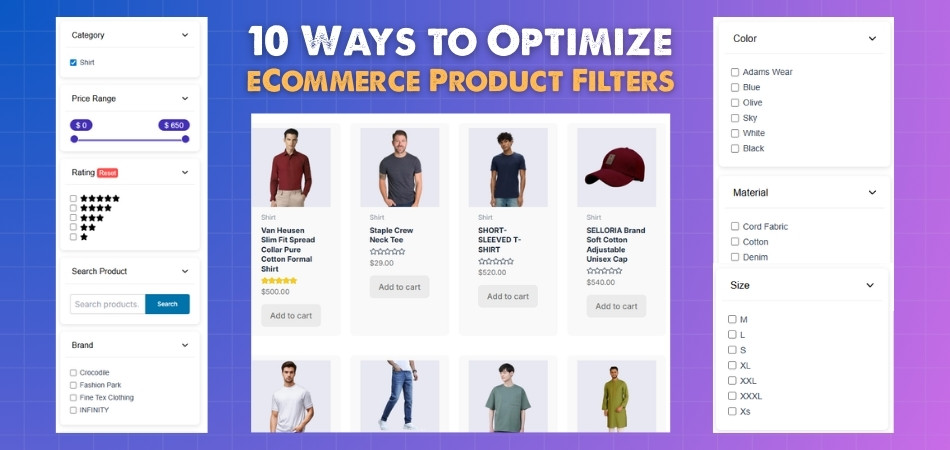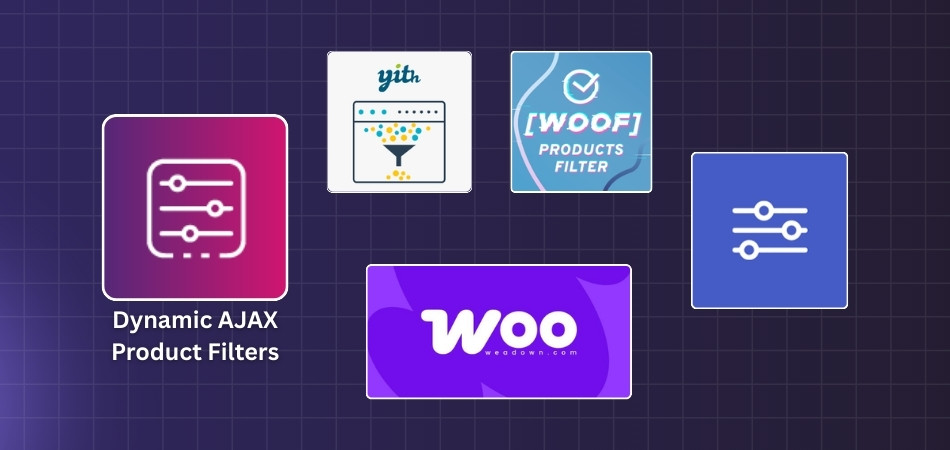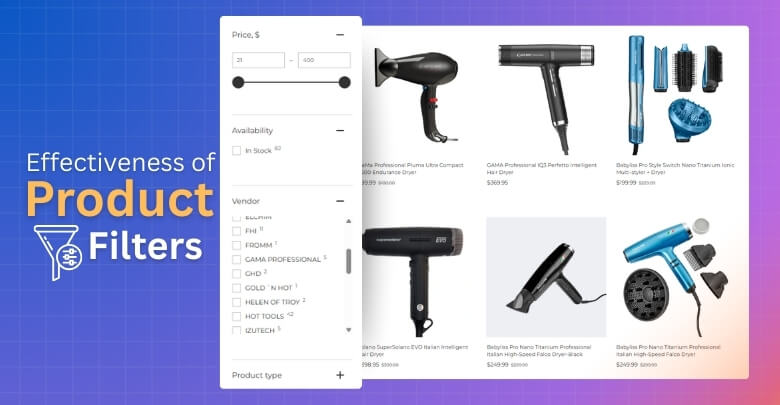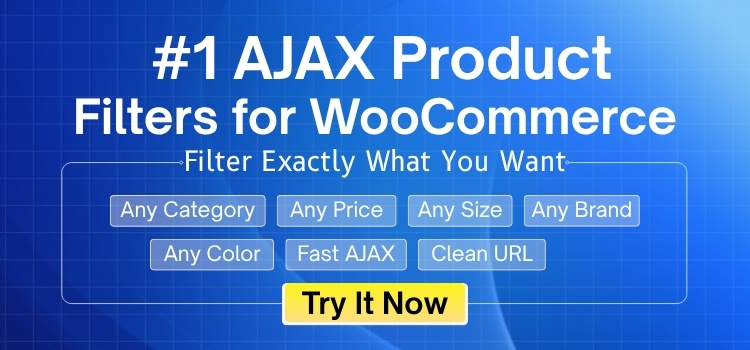Optimizing eCommerce product filters is one of the most important parts of creating a smooth shopping experience. Filters make it easier for people to find exactly what they want without wasting time. If you have ever wondered how this can be done in the best way, then you might want to learn about 10 ways to optimize ecommerce product filters.
The best way to optimize eCommerce product filters is to keep labels clear, arrange filters in the right order, prevent zero results, allow multi-select options, and make sure filters work well on mobile. These improvements save time, reduce frustration, and make shopping feel simple and enjoyable.
Want to know how to make all of this work on your own store? Or curious to see what else you can do to keep people from leaving your site too soon? Then keep reading, because this article covers everything you need to know about optimizing eCommerce product filters the right way.
10 Ways to Optimize eCommerce Product Filters
Shopping online feels simple when filters are easy to use. They help people narrow down from hundreds of options to just what they want. A smart filter setup can save time and improve buying decisions. Let’s explore some helpful ways to make product filters better.

1. Clear Filter Labels
Use words that your shoppers already use when looking for products. Avoid confusing terms that may sound too technical or brand-focused. The goal is to make the filter names match the way people think. This makes the whole process simple and direct.
Check the real search terms on your site to get ideas for clear labels. Using natural words reduces the chance of confusion and mistakes. When people understand the filter names, they use them more often. Clear filter labels save time and help shoppers find products faster.
2. Category Filters
Every product category should have its own filter options. For jackets, filters like material, insulation, and fit are important. For electronics like TVs, screen size and resolution matter more. General filters such as price and rating can stay across all categories.
Custom filters give shoppers relevant results right away. They don’t waste time scrolling through items that don’t match their needs. By focusing on what matters for each category, the shopping feels personal. This makes browsing smoother and more satisfying.
3. Thematic Filters
Some people shop with only a broad idea in mind. They may not know the exact product, but they know what kind of features they want. Adding filters based on product themes or uses helps narrow down the choices. It reduces the effort of digging through hundreds of items.
These filters give shoppers a sense of direction. Instead of clicking randomly, they can focus on smaller, more targeted sets of products. This makes the experience less overwhelming. A guided path keeps them more engaged with the store.
4. Avoid Zero Results
It feels frustrating to apply filters and end up with no products. To avoid this, hide or gray out filters that will lead to empty results. This saves people from wasted effort and keeps them moving. Always make sure there is something useful to see.
If a filter still gives zero results, offer alternatives. Suggest related products that might fit their interest. This way, they won’t feel stuck and leave the site. Keeping the shopping flow alive helps increase sales.
5. Right Filter Order
The order of filters makes a big difference in how people use them. Place the most used ones, like price, color, and size, at the top. Less important filters can be pushed lower or hidden in expandable lists. This layout makes the page less overwhelming.
When filters have many choices, show a few and add a “View more” button. This keeps the design neat and tidy. Shoppers won’t feel lost when scanning through the list. A clean layout makes the panel more inviting.
6. Simple Multi Select
Shoppers often want more than one choice, like two colors or styles. Allowing them to pick multiple values makes shopping easier. Using checkboxes for this is simple and clear. Showing chosen filters as chips or tags keeps things visible.
Make it simple to remove a filter with just one click. People should not struggle to clear their selections. Easy-to-use filters encourage more exploration. The smoother the control, the better the shopping experience.
7. Live Result Updates
Filters should update the product list instantly after a change. Showing the number of results left helps people see the effect. Using tools like Ajax product filter for WooCommerce makes updates smooth without page reloads. A fast update keeps the process quick and reliable.
Also, keep the “Apply” and “Clear all” buttons in sight. These controls give shoppers freedom to change their minds. People feel more in control when actions are clear. This builds trust and saves time.
8. Mobile Friendly Panel
Mobile shopping is common, so filters must be easy to use on small screens. A clear Filter button should open a full-screen panel. Use accordions to group sections and make tapping easy. Large touch targets prevent mistakes.
Always keep a “Show results” button at the bottom with the product count. This helps people know how many items match right away. Closing or clearing the filter panel should be fast and easy. Mobile-friendly design keeps users from dropping off.
9. Visual Aids
Pictures make filters easier to understand at a glance. Use color swatches instead of plain text for colors. Add small icons for materials or patterns. Visuals save shoppers from guessing.
Helper text or images can explain confusing terms. This support makes choices clearer for all users. Shoppers feel more confident when filters look visual. It cuts down mistakes and speeds up the decision-making process.
10. Save And Share
Let shoppers save their favorite filter settings for later. This makes it easier to come back without starting again. Saved filters improve convenience and encourage repeat visits. It creates a smoother shopping cycle.
Also, let them share filtered results with links. Friends or team members can view the same set instantly. Customer service can also send filtered links to guide people. Sharing filters adds extra value to the shopping experience.
Common Mistakes Store Owners Make When Implementing Product Filters
Product filters are designed to guide shoppers, but even small mistakes can create a poor shopping experience. Many store owners do not realize how much these issues affect user behavior. These mistakes often lead to confusion, wasted time, and fewer sales. Here are some common ones to avoid.

Hidden Filter Placement
Filters are sometimes placed where shoppers cannot easily see them. When they are tucked away in a corner or buried in menus, many people miss them entirely. This makes browsing longer and more frustrating. A hidden filter placement often reduces usage.
Overlapping Filters
Some stores create filters that overlap in meaning. Options like “fabric” and “material type” may confuse shoppers because they seem similar. Overlapping choices make people second-guess what to pick. This creates unnecessary hesitation during shopping.
No Clear Reset
One common mistake is forgetting to add a way to reset all filters. Shoppers who make several selections end up trapped in limited results. Without a reset option, they cannot easily start over. This leads to dropped searches and lost interest.
Ignoring Stock Status
Product filters often miss real-time stock updates, leaving items marked as available when they’re not. Shoppers end up frustrated after selecting unavailable products. Such gaps weaken trust and make the store feel unreliable.
Not Testing Filters
Filters are sometimes launched without enough testing. This can lead to broken links, wrong categories, or filters that don’t work as expected. Many errors also happen when store owners skip testing after using filter shortcodes safely in their setup. Shoppers notice these flaws quickly. Unchecked errors damage the store’s credibility.
Lack of Personalization
Filters are often too broad and fail to adapt to shopper behavior. Showing irrelevant or uncommon options clutters the selection panel. This makes the shopping process feel impersonal. A lack of personalization reduces shopper satisfaction.
Ignoring Analytics
Many store owners never track how filters are being used. They miss valuable insights into which filters matter and which do not. Without data, poor filters remain in place for too long. Ignoring analytics keeps the shopping experience stagnant.
Why Product Filters are Vital for an E-commerce Website?
Shopping online can feel overwhelming when hundreds of products appear at once. People want quick ways to find what suits their needs without endless scrolling. Filters make this process easier and more enjoyable. Let’s explore why they matter so much.
Better Shopping Experience
Filters improve the overall shopping experience by cutting down the time it takes to find products. Instead of browsing through endless pages, shoppers can refine results quickly. This gives them a sense of control and comfort. A smooth experience encourages them to keep browsing.
Saves Customer Time
Time is important for every shopper. Filters help users jump directly to products that match their needs. Instead of scrolling through items they don’t want, they see only the ones that matter. This speed makes the store more appealing.
Reduces Frustration
Without filters, many people get annoyed and leave the site. Seeing too many unrelated products makes shopping harder. Filters reduce this frustration by guiding users to smaller, more relevant groups. This keeps people focused and engaged.
Boosts Conversions
Filters help shoppers move faster from searching to buying. When people find what they want quickly, they are more likely to complete a purchase. A site with helpful filters often sees higher sales. Better filters can directly impact revenue.
Supports Mobile Shopping
On mobile devices, filters make browsing much easier. Small screens can feel crowded without a good filter design. Filters simplify the view and help shoppers get straight to results. This makes mobile shopping smoother and more enjoyable.
Builds Trust
When filters work well, shoppers trust the store more. They feel confident that the site is reliable and easy to use. Good filters show that the store values customer convenience. Trust often leads to repeat visits and loyalty.
Custom Code vs. Plugins for Product Filter Optimization: Which Is Better?
Building product filters usually comes down to choosing between custom coding and ready-made plugins. Each option has its own pros and cons depending on budget, skills, and long-term needs. To understand the differences clearly, let’s compare them side by side.
| Point | Custom Code | Plugins |
| Flexibility | Offers complete freedom to design filters exactly as needed. | Limited to features provided by the plugin developer. |
| Cost | Can be expensive since it often requires a skilled developer. | Usually cheaper with free or paid versions available. |
| Setup Time | Takes longer because everything must be built from scratch. | Quick setup with ready-made tools and easy installation. |
| Maintenance | Requires ongoing updates and bug fixes by developers. | Updates are handled by the plugin creator. |
| Performance | Can be optimized for speed and tailored to the site. | May slow down the site if the plugin is heavy. |
| Scalability | Scales well with unique features as the site grows. | Limited scalability depending on the plugin’s structure. |
| Security | Safer if coded properly, but risks exist without expert handling. | Security depends on how reliable and updated the plugin is. |
| Compatibility | Custom code may need adjustments for themes and updates. | Good plugins are built for easy theme and version compatibility. |
| Support | No direct support unless you hire a developer. | Many plugins provide support, forums, or documentation. |
| Control | Full control over how filters look and work. | Control is limited to plugin settings and features. |
Both custom code and plugins can improve product filters, but the best choice depends on your needs. If you want total control, custom code works best. If you prefer speed and simplicity, plugins are a smart option.
Top Product Filter Plugins for WooCommerce Site Owners to Optimize Their Product Filters
A WooCommerce store can have hundreds of products, and finding the right one should not feel like a struggle. Plugins make filters smarter and easier for shoppers to use. They add features that improve browsing and buying. Let’s look at the best choices available.

Dynamic AJAX Product Filters for WooCommerce
This plugin updates products instantly without page reloads and creates a smooth browsing experience. It offers multiple filtering styles, making it flexible for different types of stores. Shoppers can filter by price, ratings, attributes, and more in real time. It also helps optimize product filters for better performance on both desktop and mobile devices.
Features:
- AJAX Filtering, Pagination, and Sorting
- Filter by Price, Rating, Category, Tags & Attributes
- Multiple Filtering Methods
- Shortcode Compatibility
- Built-in Dynamic AJAX Filter Widget & Block
- Filter Visibility Control
- Different Filters for Different Pages
- Ready for Use on Mobile Devices
- Customizable Loader
WooCommerce Product Filter
Many WooCommerce store owners rely on this plugin because it’s proven to be reliable. It lets shoppers filter products by categories, attributes, tags, and more without any hassle. The simple design works well with most themes and is particularly effective for large online stores.
Features:
- Filter by category, attribute, tags, price, and custom taxonomies
- Easy integration with WooCommerce themes
- User-friendly interface
- Suitable for stores with wide product ranges
YITH WooCommerce Ajax Product Filter
YITH is one of the most trusted plugin developers, and its product filter tool is both flexible and powerful. It allows shoppers to quickly refine products without slowing down the site. The plugin is also very customizable, making it easy to match store needs.
Features:
- Filter by size, color, labels, price, and more
- Widgets for product attributes and categories
- Live filtering for instant results
- Compatible with most WooCommerce themes
WOOF Product Filter
Also called WooCommerce Products Filter, WOOF is an advanced option for stores that need more control. It supports a wide range of filter types and even allows custom layouts. Store owners can use shortcodes to place filters anywhere they want.
Features:
- Filter by radio buttons, checkboxes, dropdowns, and images
- Supports multi-select filters
- Shortcode support for custom placement
- Advanced filter settings for flexibility
Filter Everything
This plugin is lightweight and designed to work fast without slowing down the site. It is a great choice for small to medium stores wanting simple but powerful filtering. The setup is easy, and it works smoothly on mobile too.
Features:
- Filter by categories, tags, and attributes
- Compatible with any theme
- Optimized for speed
- Works well on mobile devices
How Often Should You Review Your Product Filters?
Filters play a big role in shaping how people move through an online store. They guide shoppers to products without wasting time. Reviewing them often ensures they remain useful and relevant as the store’s collection grows or changes.
Every few months is a healthy routine for checking product filters. Trends, seasons, and customer needs often shift quickly. A regular review avoids frustration, keeps filters fresh, and makes the shopping process smooth for returning and new customers alike.
Ignoring updates can lead to confusing filters or missing important categories. This makes people leave the store without buying anything. Reviewing filters often improves trust, user experience, and increases sales by keeping the store’s browsing experience simple and clear.
Tips for Checking the Effectiveness of Product Filters
Good product filters can make online shopping easy and smooth, but only if they actually work the way shoppers expect. Many store owners forget to test and improve them regularly. Here are some useful tips to measure their effectiveness.

Track User Behavior
Watching how shoppers use filters can show a lot about their effectiveness. If people skip certain filters, they might not be helpful. Pay attention to clicks, applied options, and time spent browsing. These details can highlight where filters succeed or fail.
Monitor Search Abandonment
When shoppers leave after applying filters, it signals an issue. They may not be finding what they want. High abandonment rates suggest filters are confusing or incomplete. Keeping an eye on this helps identify weak areas.
Check Conversion Rates
Conversion rates reveal if filters are leading people toward purchases. Low numbers may mean filters aren’t guiding shoppers effectively. Compare filtered sessions with overall sales to spot patterns. This makes it clear whether filters help or harm buying decisions.
Review Zero Results
Filters that lead to no products are frustrating. Checking how often this happens can uncover poor setups. Empty results pages can push shoppers away. Regular reviews reduce this problem and keep shoppers engaged.
Test Mobile Performance
Many people shop on mobile, so filters must work well there. Slow or clunky filters cause users to leave quickly. Test on different screen sizes to catch issues. A smooth mobile filter makes shopping more enjoyable.
Collect Customer Feedback
Direct feedback gives insight into how shoppers feel about filters. Customers often notice problems that data alone may miss. Surveys and reviews highlight areas needing improvement. Listening to feedback strengthens the overall shopping experience.
Analyze Page Speed
Filters that slow down loading harm the experience. Measuring page speed after adding filters without performance loss is an important step. If results lag, shoppers may give up. Fast filters keep customers active and reduce frustration.
Frequently Asked Questions
A smart filter setup can turn visitors into buyers, but many store owners still have questions about the details. This FAQ section covers some of the most useful and often overlooked points about optimizing eCommerce product filters. Let’s clear up the confusion one answer at a time.
How Do Product Filters Affect Bounce Rate?
Product filters play a direct role in keeping visitors on your site longer. When filters work smoothly, shoppers don’t feel overwhelmed with irrelevant products. Instead, they quickly find what they want and continue browsing. This lowers bounce rates, making your store look more engaging and trustworthy.
Why Should Filters Match Customer Intent?
Filters must align with how customers think and shop. If someone wants running shoes, they expect filters like size, type, and material. When filters don’t match intent, it creates confusion. Matching filters to intent reduces wasted clicks and increases purchase chances.
Do Product Filters Influence SEO Performance?
Yes, product filters can affect SEO. Search engines often index filtered URLs, and if not managed properly, they may create duplicate pages. Well-structured filters with proper settings help Google crawl your site better, leading to improved visibility and organic traffic.
Should Filters Be Different for Seasonal Sales?
Seasonal sales require different filter options to make browsing easier. For example, during Black Friday, filters like “Discount %” or “Limited Stock” are very useful. Updating filters for seasonal needs helps shoppers quickly spot offers, improving conversions and customer satisfaction.
How Can Filters Help With Cross-selling?
Filters can highlight related items by grouping products in meaningful ways. For instance, a filter for laptops may also show matching accessories like cases or chargers. This gently encourages customers to add more to their cart, boosting overall sales and order values.
Do Product Filters Affect Site Navigation?
Filters often act as a secondary navigation system, guiding shoppers through categories without them needing to explore menus. Well-placed filters simplify browsing by cutting out irrelevant products. When combined with menus, filters make the site easier to explore and use.
Why Should Filters Be Tested With Real Customers?
Testing filters with real customers reveals problems that analytics may miss. Shoppers might struggle with unclear terms or filter orders. Their direct feedback shows what works and what doesn’t. Practical testing ensures filters meet actual shopping expectations, not assumptions.
Final Thoughts
Making product filters better is one of the simplest ways to improve how people shop on your store. A clean and smart filter setup helps users find what they need without feeling lost or annoyed. It also shows that your store respects their time.
By following the 10 ways to optimize eCommerce product filters, you’re not just fixing a feature; you’re building a better shopping experience. These small upgrades can turn clicks into real purchases and visitors into returning customers. Filters, when done right, make a big impact.
Still thinking about what to improve first? Start small and build from there. These tips are easy to follow, practical, and tested, and they will help your store stand out from the rest.
